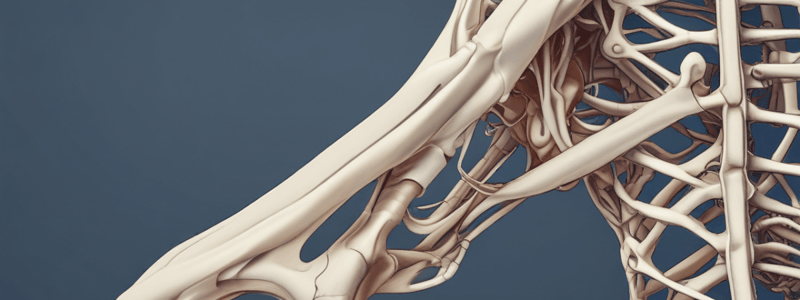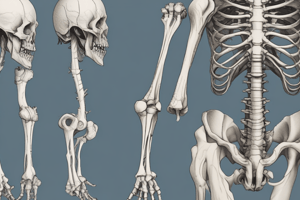Podcast
Questions and Answers
What is the composition of the pelvic girdle?
What is the composition of the pelvic girdle?
- Two femur bones and a sacrum
- Two tibia bones and a fibula
- A femur bone and a tibia bone
- Two hip bones, a sacrum, and a coccyx (correct)
What is the shape of the pelvic inlet in males?
What is the shape of the pelvic inlet in males?
- Heart-shaped (correct)
- Oval
- Circular
- Triangular
What is the function of the acetabulum?
What is the function of the acetabulum?
- It is a deep hemispherical socket on the lateral pelvic surface (correct)
- It is the lower end of the femur
- It forms the ankle joint
- It forms the knee joint
What is the largest and strongest bone in the body?
What is the largest and strongest bone in the body?
What is the bony structure formed by the hip bones, sacrum, and coccyx?
What is the bony structure formed by the hip bones, sacrum, and coccyx?
What is the main function of the lower limb?
What is the main function of the lower limb?
Which of the following bones forms the skeleton of the forearm?
Which of the following bones forms the skeleton of the forearm?
What is the primary function of the appendicular skeleton?
What is the primary function of the appendicular skeleton?
What type of joint is formed between the humerus and the scapula?
What type of joint is formed between the humerus and the scapula?
What is the name of the cavity in the scapula that forms the shoulder joint?
What is the name of the cavity in the scapula that forms the shoulder joint?
What is the function of the clavicle?
What is the function of the clavicle?
What is the name of the bone that articulates with the scapula and radius and ulna?
What is the name of the bone that articulates with the scapula and radius and ulna?
What is the name of the surface of the scapula that articulates with the humerus?
What is the name of the surface of the scapula that articulates with the humerus?
What is the function of the pectoral girdle?
What is the function of the pectoral girdle?
What is the function of the patella?
What is the function of the patella?
Which bone does not contribute to the knee joint?
Which bone does not contribute to the knee joint?
How many metatarsal bones are there in the foot?
How many metatarsal bones are there in the foot?
What is the function of the interosseous membrane?
What is the function of the interosseous membrane?
What is the name of the bone that receives the weight of the body from the femur?
What is the name of the bone that receives the weight of the body from the femur?
Which of the following bones has a styloid process?
Which of the following bones has a styloid process?
Flashcards are hidden until you start studying
Study Notes
Bones of the Lower Limbs
- The lower limb consists of the femur (thigh), tibia and fibula (leg), tarsals (ankle), metatarsals (foot), and phalanges (toes)
Pelvic Girdle
- Composed of two hip bones, sacrum, and coccyx
- Hip bones unite anteriorly with each other at symphysis pubis
- Articulates posteriorly with the sacrum
- Formed by hip bones, sacrum, and coccyx
- Divided into two regions: true (lesser) pelvis and false (greater) pelvis
Hip Bone
- Composed of ilium, ischium, and pubis
- Acetabulum is a deep hemispherical socket on the lateral pelvic surface
Sex Difference of the Pelvis
- Pelvic inlet is oval in female and heart-shaped in male
- Ischial spines don't project medially in the pelvis in female
- Pubic angle is 80-90 in female and 50-60 in male
The Lower Limb
- Carries the entire weight of the erect body
- Bones of the lower limb are thicker and stronger than those of the upper limb
- Divided into three segments: thigh, leg, and foot
Femur
- Is the largest and strongest bone of the body
Appendicular Skeleton
- The primary function is movement
- Includes bones of the upper and lower limbs
- Girdles attach the limbs to the axial skeleton
Skeleton of the Upper Limb
- Consists of the shoulder girdle, arm, forearm, and bones of the hand
Pectoral Girdle
- Consists of two clavicles and two scapulae
- Provides attachment for many muscles that move the upper limb
- Girdle is very light and upper limbs are mobile
- Only clavicle articulates with the axial skeleton
- Socket of the shoulder joint (glenoid cavity) is shallow
Clavicle
- Provides attachment for muscles
- Holds the scapulae and arms laterally
- Transmits compression forces from the upper limbs to the axial skeleton
Scapula
- Has three surfaces: costal, dorsal, and spinous
- Dorsal surface is divided by the spine into supra-spinatus and infra-spinatus fossa
- Angles of the scapula include superior, lateral, and inferior angles
Humerus
- Is the largest bone in the upper limb
- Articulates superiorly with the scapula and inferiorly with the radius and ulna
- Has upper and lower ends and a shaft
Patella
- Triangular sesamoid bone
- Imbedded in the tendon that secures the quadriceps muscles
- Protects the knee anteriorly
Leg
- Refers to the region of the lower limb between the knee and the ankle
- Composed of the tibia and fibula
- Tibia articulates with the femur at the superior end and forms the knee joint
- Tibia articulates with the talus at the inferior end and forms the ankle joint
- Fibula does not contribute to the knee joint but stabilizes the ankle joint
Fibula
- The fibula has upper and lower ends and a shaft
- The upper end has a styloid process, head, neck, and tibial notch
Bones of the Foot
- Consist of tarsals, metatarsals, and phalanges
- There are 7 tarsal bones, 5 metatarsal bones, and 14 phalanges
- First metatarsal supports body weight
Studying That Suits You
Use AI to generate personalized quizzes and flashcards to suit your learning preferences.




